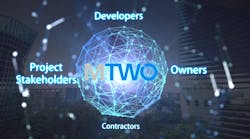ITS AMERICA: A conversation with Regina Hopper
Amidst an intensive schedule that reflected both the demands of her position and sponsors’ and attendees’ desire to interact with the new president, Ms. Hopper made time to sit down with TM&E to discuss some issues related to ITS now and in the near future. The following is an edited transcription of that conversation.
Regina Hopper: I’m glad to be speaking with you. You know we’ve gotten to a point, a cusp, now [with ITS] where it used to be the insiders speaking with and sharing information with one another, but now it’s the outsiders and the outside audience who want to begin to understand what [ITS] means. The outside world is beginning to look inside, which makes developing ITS even more interesting—and more challenging.
TM&E: Information sharing within the industry is crucial to rapid development. Since there are a lot of companies developing different technologies but few or none that have an overarching system or methodology to hem all those together from an operational perspective, how do see information sharing happening, when everyone in essence has a product, something to sell, something they feel is the “solution?”
RH: I came out of US Telecom when wireless came about, when it was initially developed and rolled out, when it was real in its application for everyday people, and it was the same thing then too. I think this happens in any industry that progresses so rapidly. The challenge for DOTs is to acquire technology that adapts to their present infrastructure and also will carry out into the future, in both software and hardware, and that can adapt to other things as well that come along in the future. It’s like, ‘It’s my responsibility to buy something that doesn’t become the BetaMax.’ So how did I make these decisions? ITS America is the unique intersection of the public and the private, coming together, where a subject as important as safety for vehicles and the traveling public can have the public and private working together. Because if the private goes out on its own, and things don’t work out as planned, the public has to take care of the safety issues. And if the public/DOTs adapt technology that doesn’t last, they answer to the taxpayers. Here, ITS America serves as that place where they can meet and share, and it will become even more important in the future.
TM&E: Autonomous vehicles and automated vehicles are obviously different things; but there is a lot of talk about autonomous being viable in five years. How can that be possible when there is no infrastructure to support them, except in perhaps very small pockets of society?
RH: Yes, you’re not going to put the Google car out on the Beltway.
TM&E: More like a golf-cart community.
RH: Someone actually said that to me today! If you look at as an answer to an issue for a segment of society, for example those who cannot see or has a physical disability, or even an older population with degraded driving skills, you see a solution viable much sooner. Technology drives societal questions. We’ve seen it with Fitbits, for example; do we really need to be tracking all aspects of our fitness? Yeah, a lot of folks do. Or cell phones. Technology development is faster than adaptation. But that doesn’t mean it should slow down.
TM&E: Do you see vehicular technology as being cost-prohibitive?
RH: I don’t really know. Those cost implications are basically kept within the companies doing the development. If you take a 30,000-ft view, the infrastructure in the U.S. is in the ICU. It’s past critical. And so while the political conversations continue, you’ve got a critical issue taking place going into an election year where even on the best days, it’s a struggle to come down to a decision. This technology might serve as an overlay to some of these problems. Can it fix the potholes? No. But it can help provide information as to the extent of that damage. It becomes a question of return on investment. How much do you spend and when do you spend it? The Utah DOT director yesterday told me that whenever his department lays or even fixes a road, they put down fiber in advance of developing technology coming through, so they’ll be ready to go when something happens and they can develop.
TM&E: Do you think it would ever come down to a question of developing ITS for automobile infrastructure versus for public transit system infrastructure? Because there is only so much money to go around, and there will never be enough. For example, in Chicago there are an enormous number of cars and not enough road capacity to tolerate them, despite major project development, and yet there is a pretty solidly laid-down public transit network that does not operate as efficiently or dependably as it should and that is linked directly to lack of funding support for maintenance and development.
RH: Well, you’ve got to look at this from an intermodal perspective. Technology lets you do that much more easily than the siloed perspectives of the past. You’ll never be able to fight for monies that are going someplace else. The coming generation want urban living. And you see cities trying to take all modes of transportation—and all the things associated, such as parking and payment—and make them sufficiently interface into a whole system. The ultimate goal is seamlessness. Which will require incredible cooperation. Going back through history—railroads, the highway system, mass transit—all were the result of desired economic development and concerned parties talked to one another. Information-sharing got it done. We’re going to have to go back to that for how we take care of our infrastructure now. Not that it doesn’t entirely happen now; it’s just not happening perhaps well enough. As I was saying before, the great thing about ITS America is that here a lot of those [concerned parties] come together.
TM&E: In terms of sustainability measures, how do you see ITS America playing into that?
RH: I’m still trying to figure that out. [Ed note: Ms. Hopper at the time of this interview was less than two weeks into her appointment as president and CEO.] We have forums, conferences, meetings, state chapters, international chapters and so on. I do know that my job is to make the conversations around ITS development and deployment more relevant, and to make ITS America more relevant. My experience is to work with all concerned parties and to have very serious conversations to address where we want to go and what we want to be as time moves forward. We’re kind of a ‘tween’. We’re not a child but not quite fully grown. We’ve got enormous potential. Now that the outside audiences are paying attention, what do we want to be? That’s what I’m looking to find out.
TM&E: One final question: Do you think autonomous technology will ever really replace or supersede the human need for control?
RH: Or even the desire to drive, right?
TM&E: Exactly. There seems to be a risk level most people just won’t trust. Can it be overcome?
RH: There’s always a level of fear or mistrust when new technology comes out. We’re all scared of technology at first. For me, when Uber first came out, I was concerned about security. You know, should I put my credit card in here? Is it secure? Is it safe? When it comes to your physical safety, that’s a whole other set of issues. Those in the industry will admit there’s a long way to go. What will that take? It’s as much psychological and experiential as practical. And people like to drive. Will we have a generation that accepts being driven? The Washington Post recently did a story that said ‘Everyone can have a chauffeur?’ It will be interesting to see how it develops. Five years seems like an awful short time to make that juxtaposition from control to giving up control. Automakers are researching it. But it might well take a generation [to fully accept it]. And there will be a driver training aspect, as well. Do I feel okay getting in a driverless car? Will my children be okay with it? The younger generation expects things to work, because that’s what they were raised with, with all this technology; our generation expects things to have to be worked out with technology. We don’t expect it to work first, especially early adopters. And that’s where we’re at.


